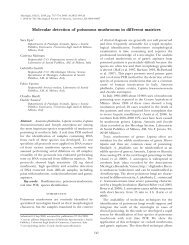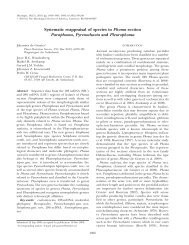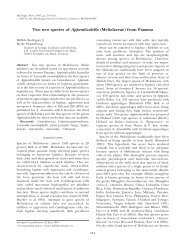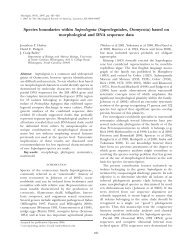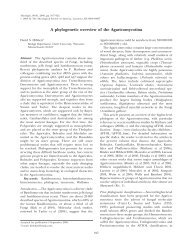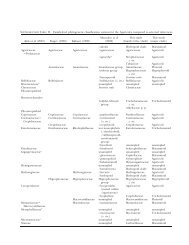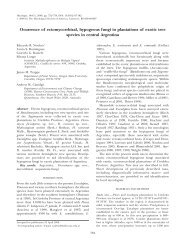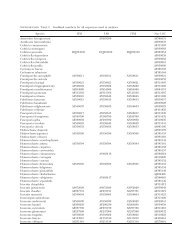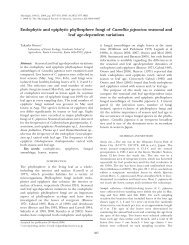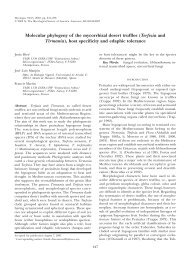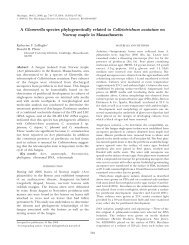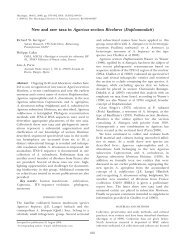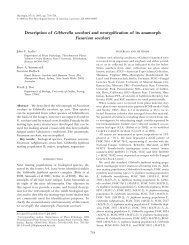Short title: Revision of Morchella taxonomy Taxonomic ... - Mycologia
Short title: Revision of Morchella taxonomy Taxonomic ... - Mycologia
Short title: Revision of Morchella taxonomy Taxonomic ... - Mycologia
You also want an ePaper? Increase the reach of your titles
YUMPU automatically turns print PDFs into web optimized ePapers that Google loves.
pits, as compared to the finely tomentose pits <strong>of</strong> M. brunnea specimens examined; further<br />
collections <strong>of</strong> both phylogenetic species may determine whether this difference is consistent.<br />
<strong>Morchella</strong> brunnea is mentioned as M. angusticeps in Weber (1995) and is treated as the "natural<br />
black morel" in Pilz et al. (2004, 2007). It was treated as one <strong>of</strong> several "Classic North American<br />
Black Morels" in Kuo (2005).<br />
<strong>Morchella</strong> septentrionalis M. Kuo, J.D. Moore & Zordani, sp. nov. FIG. 19<br />
MycoBank MB 563961<br />
Ascomata 40–75 mm alta; capitulum conicum vel subclavatum; costae fuscae, nigrescentes aetate; hymenium<br />
fulvum usque fuscum; biotopium in silva frondosa in alta America septentrionalis; sporae 20–22 × 11–15 μm.<br />
Holotypus: Biotopium sub Populus grandidentata Michx.; USA, in Michiganense, ad Cheboygan County; R.<br />
Zordani col.; specimen typicum in Herb. F (05110405) conservatum.<br />
Etymology. The epithet reflects the northern distribution <strong>of</strong> the species.<br />
Ascomata 40–75 mm high. Hymenophore 30–45 mm high; 15–25 mm wide at the widest<br />
point; conical, bluntly conical, or subclavate; pitted and ridged, with 14–20 primary vertical<br />
ridges and occasional shorter, secondary vertical ridges, with occasional or frequent sunken,<br />
transecting horizontal ridges; attached to stipe with a sinus about 2–3 mm deep and 2–3 mm<br />
wide. Ridges finely tomentose or nearly glabrous; tan to brown or dark brown, blackening with<br />
maturity; flattened when young but with age sometimes becoming sharpened or eroded. Pits<br />
primarily vertically elongated; glabrous; pale tan to dull brownish yellow or grayish brown. Stipe<br />
20–30 mm high; 8–15 mm wide; more or less equal or sometimes basally subclavate; finely<br />
mealy with whitish granules; whitish to pale brownish; sometimes developing a few folds near<br />
the base with maturity. Context whitish; up to about 1 mm thick. Sterile inner surface whitish<br />
and pubescent. Ascospores (19–)20–22(–25) × 11–15 μm; elliptical; smooth; contents<br />
homogeneous. Asci 225–350 × 15–30 μm; eight-spored; cylindrical; hyaline in KOH (2%).



